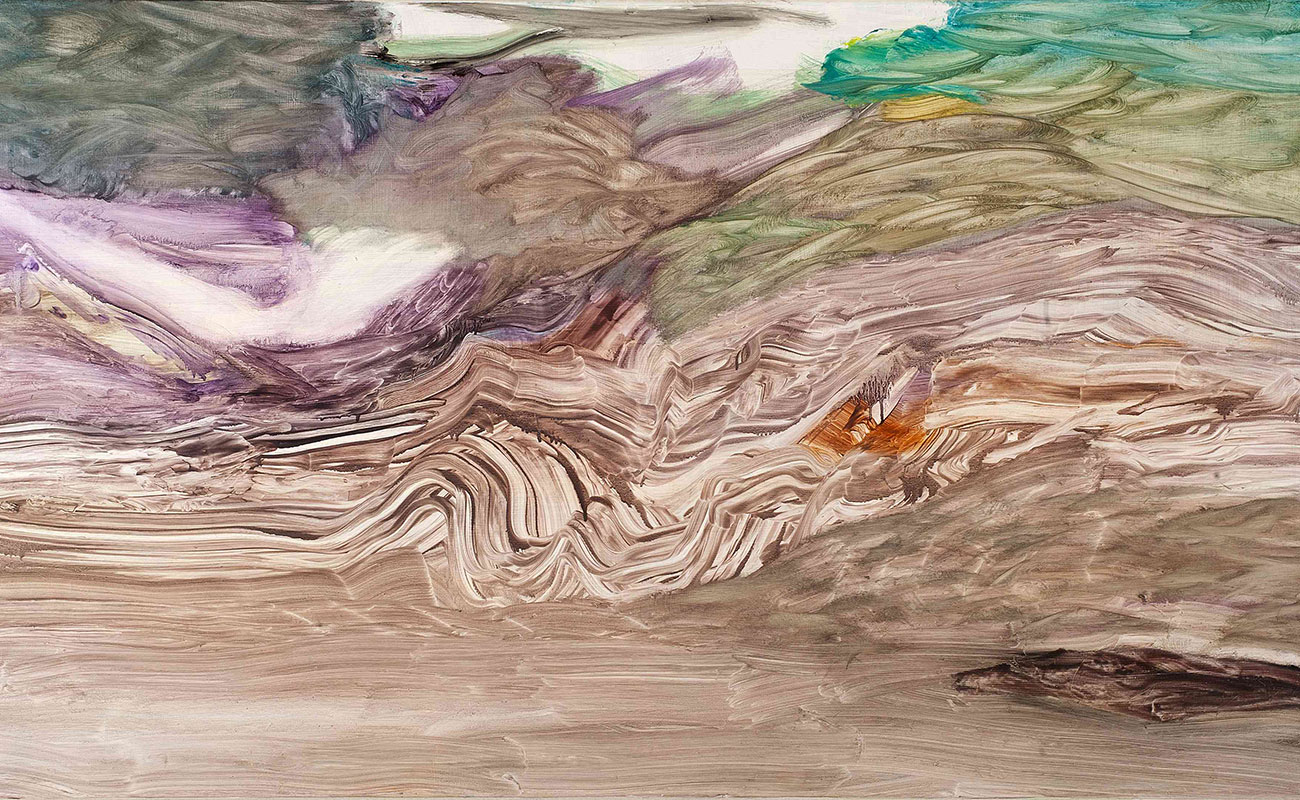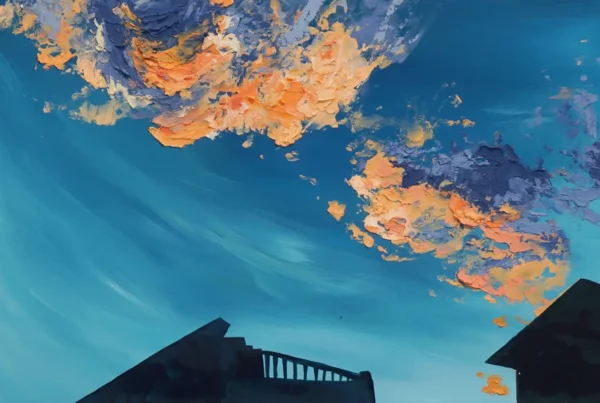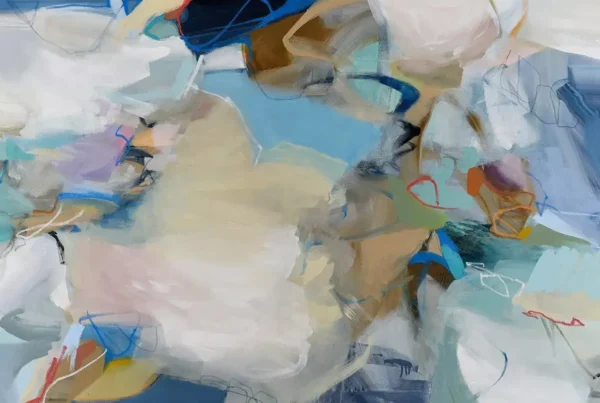“The most significant revelation I’ve gained through my artistic journey is the unveiling of my authentic self and the manifestation of a higher force that guides and inspires me throughout the creative process.”
Embracing Nature and the Unpredictable in Art
Annette Zumkley began her artistic journey as a career changer, having spent her early years immersed in the tranquility of the countryside. The expansive landscapes and natural surroundings ignited Zumkley’s creative passions. Despite her initial lack of knowledge in the field, she cultivated an insatiable curiosity and an eagerness to learn more about the arts. It was not until she was 32 years old, during her family phase and parental leave with her two eldest daughters, that Zumkley seized the opportunity to study at the University of Fine Arts in Münster, eventually earning a degree in free art in 1998.
Zumkley’s artistic journey led her to discover her true essence, experiencing the presence that flowed through her and manifested in her creative works. In 2001, the artist welcomed her third daughter into the world.
Zumkley particularly thrives when working on large-scale pieces, which allow her the freedom to engage fully and physically with her craft. After completing her degree, she was fortunate to gain access to a 200-square-meter studio, where she developed a series of large-format acrylic works.
Fascinated by the movement of color on the painting surface, Zumkley observed how watery acrylic paint on a horizontal canvas interacted with her brushstrokes, merging and often taking unpredictable paths. Spontaneity, rhythm, and repetition emerged as fundamental forms of expression in her finished pieces, though they could just as easily disappear in the color gradients. Utilizing the glazing and opaque properties of acrylic paint, Zumkley created multi-layered surfaces that appeared profound and dynamic to viewers.
For Zumkley, the natural world serves as both her observation point and her primary source of inspiration. Through her connection to nature, she perceives and channels forms of movement, tension, energy, and rhythm into her paintings, resulting in a distinct and captivating style.
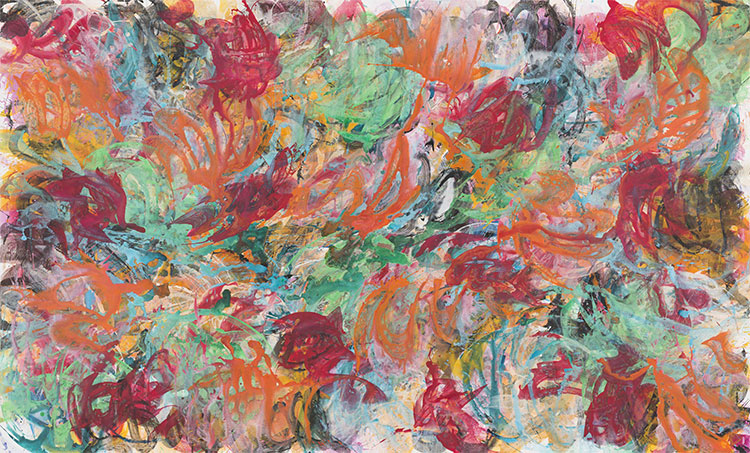
Experimentation and the All-Over Structure in Zumkley’s Work
Focusing solely on the repetitive and decorative elements in Annette Zumkley’s artwork would be an oversimplification, despite the fact that many of her paintings are permeated with pulsating rhythms akin to a heartbeat. The unpredictable dynamics of color gradients juxtapose with the regularity of these rhythms, engaging in a captivating interplay that enriches her creations. At times, the emphasis shifts between rhythm and free color gradients, demonstrating the versatility of Zumkley’s oeuvre.
A hallmark of Annette Zumkley’s work lies in her experimentation with color, marked by surprising, idiosyncratic reactions and effects, as well as the intuitive control she exercises, particularly evident in the continuous rhythm of concentration and relaxation. Many of her paintings possess an all-over structure, characterized by a unified treatment of the canvas that extends beyond the edges, transcending the margins, and evoking the sense of a fragment from a larger entity. This approach enables the inherent vibrations and rhythms to be seamlessly presented within the space, as noted by art historian Annegret Rittmann.
Zumkley meticulously primes her canvases multiple times with a thin liquid and sands them until achieving a velvety-smooth surface, which facilitates paint dripping and the formation of stubborn trickles. Following each application of acrylic paint, an extended drying process ensues.
Zumkley’s artistic development emerges from a series of interconnected, recurring processes that mutually support one another. Although there are phases in which she attempts to express her own ideas and concepts, she often relinquishes them, allowing for the emergence of a unique visual language through intention-free action.
In contrast to the expansive canvases, Zumkley’s works on paper display a more relaxed sequence of color dabs, serving as small-scale experiments with transparent and dripping paint layers. Guided by quiet attentiveness, the brush on the paper creates colorful surfaces and non-representational compositions that further showcase her versatile artistic capabilities.
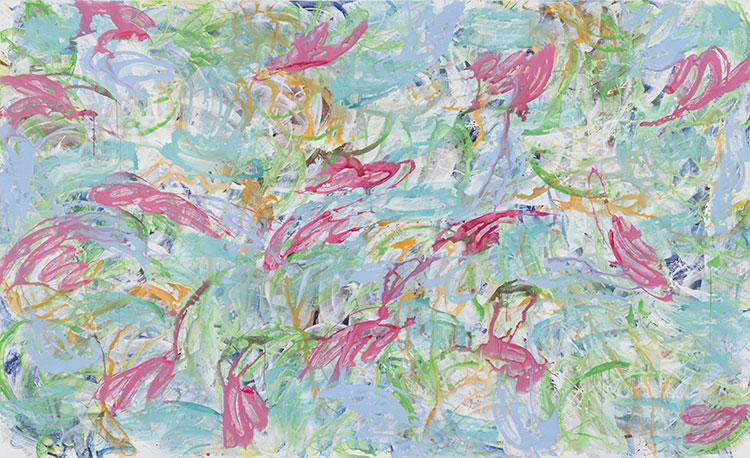
Annette Zumkley: Studio Environment and Concentration
Over time, Annette Zumkley’s canvas paintings have evolved beyond a uniform all-over structure with a clearly established rhythm. Her dynamic strokes and color gradients now exhibit a greater sense of liberation, no longer bound to a consistent foundational beat. Zumkley’s energetic creations are characterized by unrestrained, generous, and spirited gestures. When observed from a distance, larger contexts of movement emerge from the sequences of gestural brushstrokes, revealing openings and evoking a palpable sense of space. The gesture serves as the driving force, surpassing the interwoven nature of the paintings, which feature repetitive color patterns and vigorous sweeps engaged in an interplay between optimal freedom and the pursuit of new connections.
In 2021, a significant shift took place in Zumkley’s artistic process, triggered by a change in her working environment. She transitioned to a studio space located within a former hospital. The high-ceilinged “rooms” were separated, and the floor lacked running water, initially leaving the artist feeling restricted and unable to continue her previous work that was influenced by the openness of her former space.
Upon visiting numerous artists’ studios and art academies, few spaces demonstrated the order and near-emptiness observed in Zumkley’s workspace. There was an absence of clutter and personal belongings, as all materials were neatly organized and tucked away. The studio, a former storage room, was furnished minimally with just two chairs, and no radio or other distractions were present. The atmosphere was characterized by an even, diffused light and the scent of the surrounding concrete walls. This environment allowed for an unobstructed focus on her paintings.
The orderly nature of Zumkley’s workspace is not a coincidence, but rather a deliberate choice. She views her studio as a pure working space, devoid of distractions, allowing her to concentrate on thinking and creating. For Zumkley, this external order is essential for her mental development. This disciplined approach extends to her time management as well; she maintains a routine, commuting to her studio daily to work on her paintings in almost rhythmic units of time.
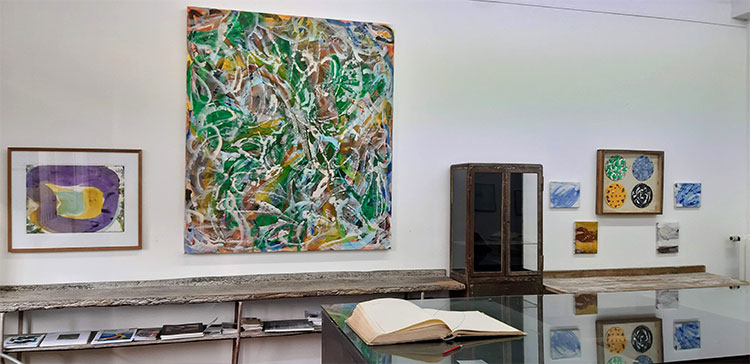
Adapting to Change and Evolving Through Space and Medium
Annette Zumkley’s artistic evolution has been significantly influenced by the spatial conditions of her studio environments. The low-ceilinged, elongated 20-meter studio space she initially occupied favored landscape formats in her work. However, in 2018, Zumkley transitioned to a studio of similar size with high ceilings and a square floor plan, which prompted a shift towards creating primarily portrait-format works measuring 230 cm to 280 cm.
Zumkley’s artistic journey began with the creation of small 15 cm x 20 cm oil-on-wood paintings. She was captivated by the luminosity and depth effect of fine oil paints and the myriad possibilities that arose from experimenting with the medium. This ongoing series of panel paintings ignited her desire for more expansive works, leading to the development of large-format series such as “With a New Perspective” and “Movements,” which explore landscape designs and immerse viewers in nature from unique vantage points.
The artist’s experience of landscape and her affinity with nature and her own self have guided her brushstrokes. At the outset, her paintings featured transparent, almost diaphanous layers of paint, structured by the distinctive style of her hand. These layers, placed alongside and atop one another, soon evoked analogies to mountains, rocks, and ocean surf through their gestural structures.
Zumkley’s works are powerful and energetic, inviting viewers to focus on novel perspectives, detached from collective fears, confusions, and desires. Art historian Annegret Rittmann interprets the artist’s sculptures as metaphors for life, with rhythmically flowing movements and structures reflecting the cycles of becoming and passing, day and night, seasons, and even the rhythm of the human heart and breath. These works also acknowledge the presence of chaos, unpredictability, and uncontrollable elements, which defy human influence and give rise to infinite variety.



